Travel And Tourism Business Toolkit Assignment (Doc)
Added on 2021-02-20
21 Pages5897 Words48 Views
TRAVEL ANDTOURISMBUSINESSTOOLKIT
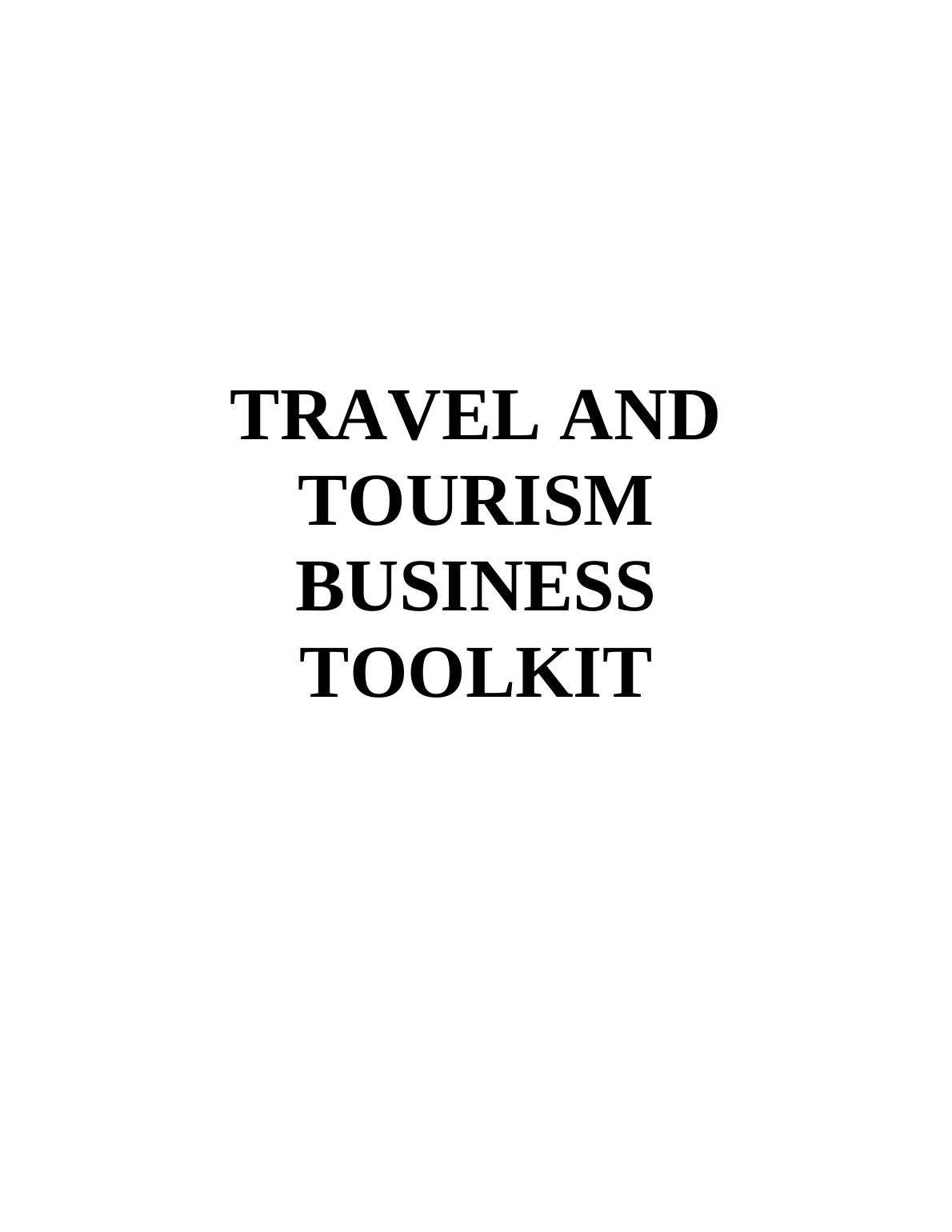
Table of ContentsINTRODUCTION...........................................................................................................................1PART 1............................................................................................................................................1LO 1.................................................................................................................................................1Rationale and Principles of Revenue Management................................................................1Application of Revenue Management Tools to Generate and Maximise Profit....................2Impact of Differentiated Pricing Strategies on Revenue Management..................................3Critical Analysis of Principles of Revenue Management.......................................................3LO 4.................................................................................................................................................4Different Types of Financial Statements and Reporting Mechanisms...................................4Importance Budgets for Controlling Business Performances and Identifying Variances......5Interpretation of Financial Statements and Reports...............................................................6Evaluation of Business Performance based on Financial Statements and Reports................9PART 2..........................................................................................................................................10LO 2...............................................................................................................................................10Different Stages of HR Life Cycle.......................................................................................10Performance Management Plan............................................................................................12Importance of HR Life Cycle...............................................................................................14Judgement and Recommendations.......................................................................................14PART 3..........................................................................................................................................15LO 3...............................................................................................................................................15Specific Legislations that Travel and Tourism Industry have to comply.............................15Impact of company, employment and contract law on business decision-making..............15Examination of potential implications of regulations, legislation and standards on decision-making..................................................................................................................................16Critical Reflection on Potential Impact of Regulations, Legislations and Ethical Principles onbusiness decision-making.....................................................................................................17CONCLUSION..............................................................................................................................17REFERENCES..............................................................................................................................18
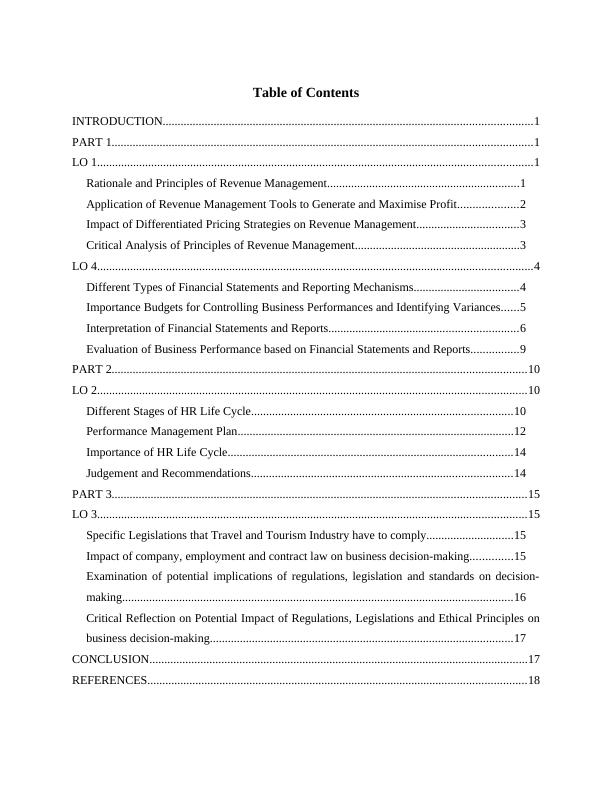
INTRODUCTIONTravel and Tourism includes all the activities that are associated with travelling,entertaining tourists, accommodating and maintaining leisure of travellers (Travel and Tourism,2019). This industry is very much vast and covers a wide range of sectors that are inclusive ofaspects like travel planning, accommodation, tourist attractions, transport, food, leisure, etc. Thereport below is based on Travel and Tourism Business Toolkit, for which Thomas Cookorganisation is selected. The report is divided into three parts which includes Sales, Budget andRevenue Management, HR Life Cycle & Human Resource Strategy and Legislation & Ethics inTravel and Tourism.PART 1LO 1Rationale and Principles of Revenue ManagementConcept of revenue management: Revenue Management refers to effective and essentialprocedure within the organisation associated with appropriate anticipation of consumer demandto optimise inventory as well as price availability, which then assists the firm in maximising theirrevenues.Principles of revenue management within travel and tourism industry:Market Segmentation:The very first principle of revenue management is market segmentation. This is a processthat is used within the industry to divide the whole market within potential segments, wherespecific attributes are given importance regarding effective division of the marketplace. Withinthe travel and tourism industry, specific rates are decided on different segments, from wherethere could be maximum revenue generation.Demand Forecasting:Another principle of revenue management is Demand Forecasting. Within this principle,the industry appropriately anticipates the rise or fall of demand within different travel andtourism activities. However, there could be two situations that are likely to arise in this principle.For instance, in case there are high forecasting mistakes within the industry, its outcome isconservative inventory controls. On the other hands, in case low forecasting errors are performedwithin the industry, it would result in aggressive controls over inventory.1
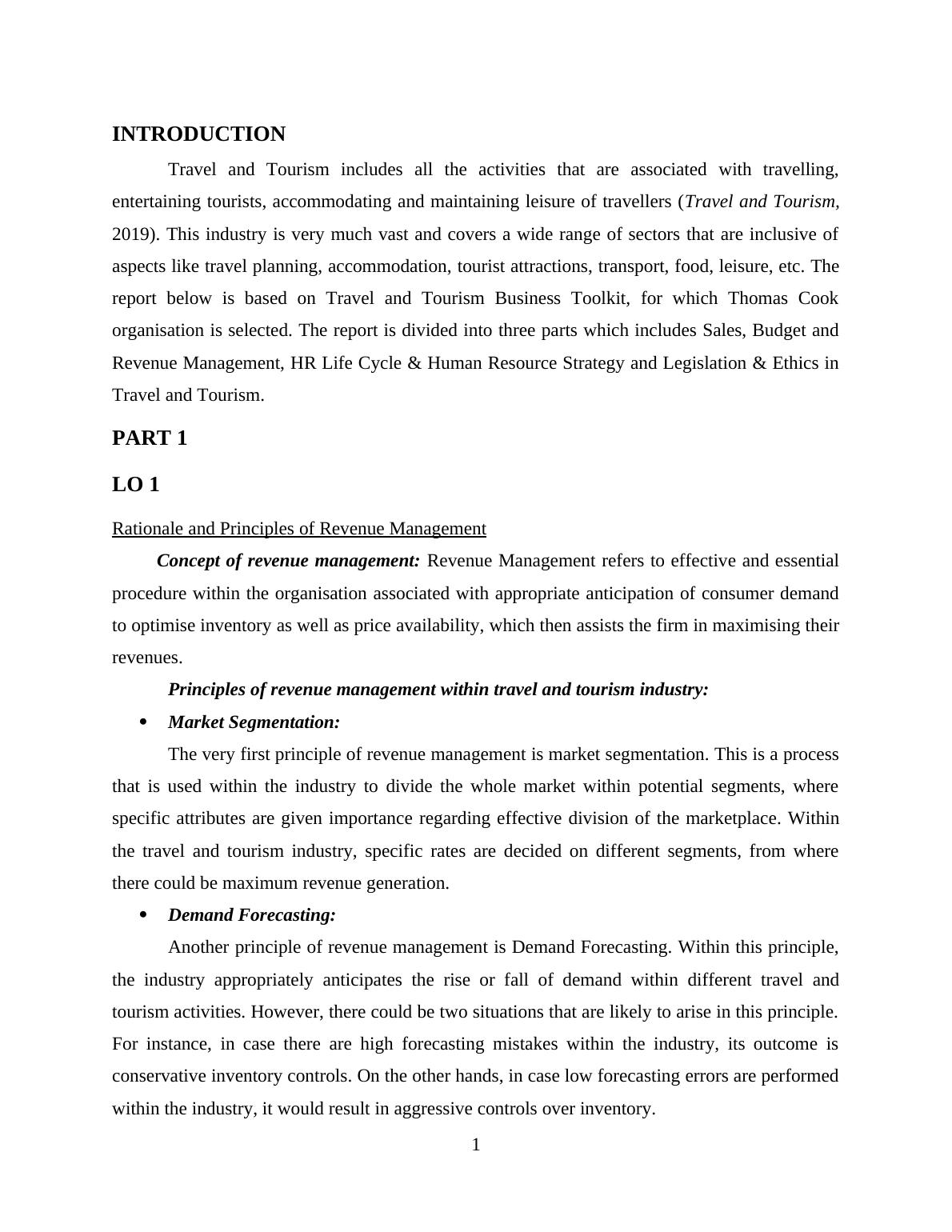
Overbooking Control:This principle is associated with the process of managing overbooking within theindustry, wherein bookings are made in bulk but people do not show up (Pont, 2014). Thus, thisprinciple deals with the fact that managing overbooking effectively could lead to appropriate andeffective revenue generation, which could otherwise be a big concern for the industry.Application of Revenue Management Tools to Generate and Maximise ProfitThere are several revenue management tools that could easily be applied within the travelplanning sector of Thomas Cook to ensure generation and maximisation of profit. Some of thekey tools regarding the same are discussed below:Capacity Utilisation:The very first tool in order to enhance profitability is capacity utilisation. This tool dealseffectively with utilising and managing the available capacity in manner that helps the companyin full occupancy. However, this is ongoing process which is adopted within travel planning, asthis goes effectively till the execution of overall event or tour. Moreover, one appropriate waythrough which this tool could be effectively utilised by Thomas Cook is to provide attractivefacilities and no-cancellation policies, which encourage individuals to ensure full capacity. Discount Allocation:This tool is associated with providing discounts in manners that encourage individuals interms of adopting the facilities provided by the firm. Travel Planning is the sector whereindemands could be created by providing discounts on locations or facilities that have potential togenerate high demands. This demand could be used by Thomas Cook to appropriately drivecustomers towards their provided offerings and enhance the scope of profitability.Duration Control:It deals with charging limits upon acceptance of reservation requests in manner whichallows the organisation to protect adequate space for multi-day requests, that might enhance thescope of more profitability for the company. Thomas Cook could hold in several spaces withinits reservations for last moment bookings which could effectively generate higher revenue due tobeing in demand.Apart from above revenue management tools, Thomas Cook can use few other tools aswell with the help of information technology. These tools are automated booking engine (which2
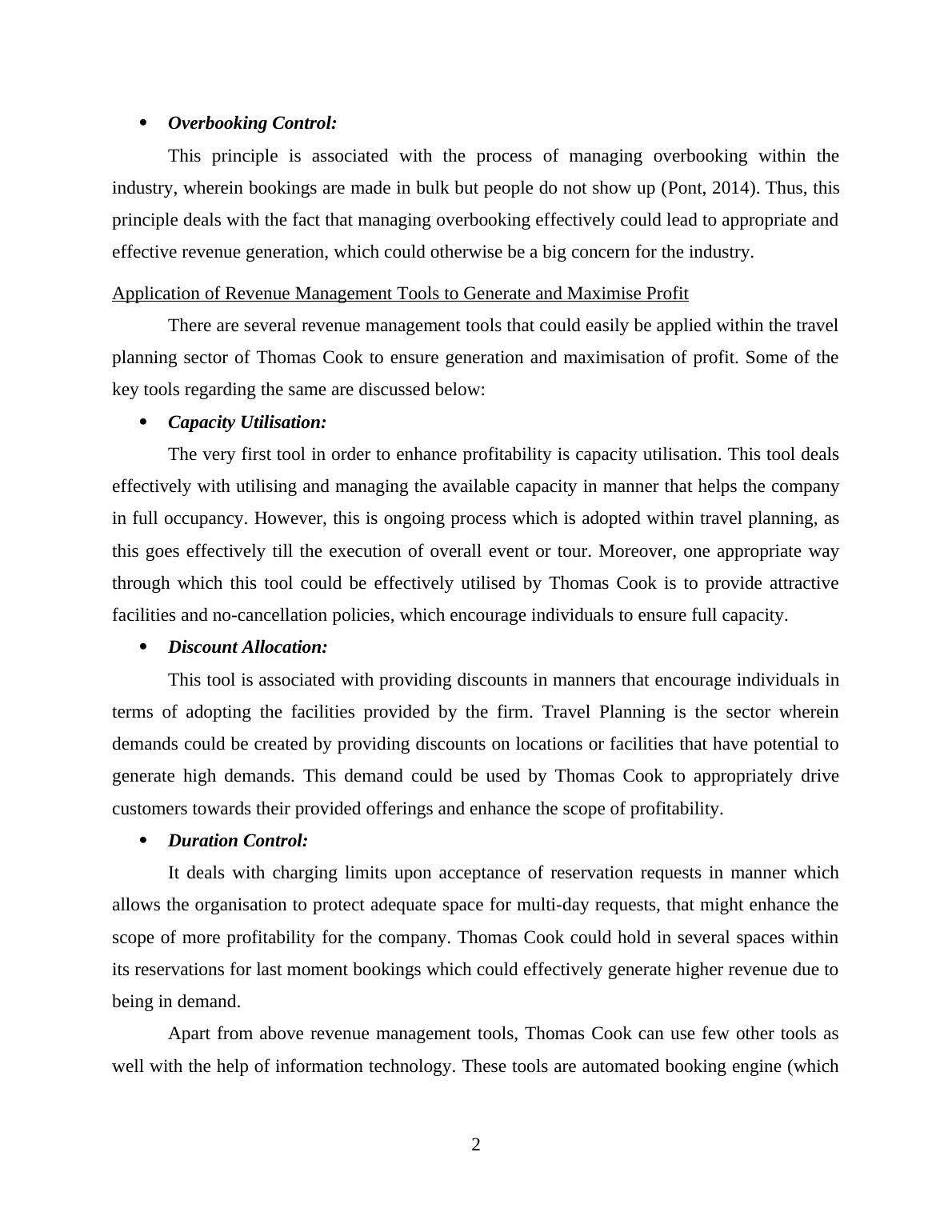
can manage all the booking of travellers) and Online channel manager (which can automaticallymanage all the inventory). Impact of Differentiated Pricing Strategies on Revenue ManagementDifferential Pricing strategies refer to a procedure of charging different prices on similarproduct or service offerings depending on attitudes. Specific impacts on different strategies arementioned below:On basis of Offering:Sometimes, during travel planning, different destinations are priced at different pricerates. For instance, pilgrimages or spiritual places might cost less to elderly to encourage othersto join in. Impact of the same is that the firm might assure profitability for itself in context withproviding different destinations on different prices on the basis of demands of offering.On basis of Payment Terms:There are several modes of payments as well as different payment policies regardingspecific offerings. Thus, differential pricing on payment terms could mean charging lower rateson payments made through credit or debit card companies, which the firm is associated with.Such aspect has a positive impact on the company as more users are encouraged to associatethemselves with other companies which have ties with the firm and thus, this is another source ofrevenue for the firm.Critical Analysis of Principles of Revenue ManagementMarket Segmentation:Thomas Cook deals in several sectors within travel and tourism industry. However, themost prominent sector within the same is travel planning. Market segmentation is effectivelyapplied within this sector as the firm segregates the market according to age, preferences as wellas types of tourist activities. However, the segmentation of the company lacks on the grounds ofproviding a variety of activities, which results in lesser segments, thus, limitation in revenuegeneration.Demand Forecasting:Within travel planning, forecasting demand is very much essential in terms of ensuringhigh revenue generation. In Thomas Cook, Demand Forecasts are performed on the basis ofcurrent performance of different travel and tourism attraction, moreover, prevailing trends asrevealed by google analytics and other essential software. This assists the firm in focusing on3

resources having high revenue potential. However, locations and activities within the firm arelimited, which revokes it to generate higher revenue in case demand arises for specific activity orplace that is outside their scope.Overbooking Control:Within Travel Planning, Thomas Cook takes an effective approach towards controllingthe overbooking issue within the industry. It does so by effectively adopting a “No Refundpolicy”, which guarantees maximum booking and effective revenue generation. However, abetter approach could be to deliver a timeline along with the policy, wherein maximum bookingswould be done and locked up, to ensure maximum scope of revenue.LO 4Different Types of Financial Statements and Reporting MechanismsFinancial Statements are the projections within the company which reveal itsperformance in quantifiable terms. There are different types of financial statements within anorganisation, some of which in context of Thomas Cook are mentioned below:Income Statement: This is the report within an organisation, which appropriately revealswhether the firm was able to generate profit or not. For Thomas Cook, this reveals all thedetails within the firm's operations which contribute to income and profitability. Thisreport includes all the expenditures which organisation has occurred in order to operate inmarket which are deducted from total revenues to ascertain net profit earned. Cash Flow Statement: This statement effectively shows all the sources, as well as theamounts of cash which is flowing in as well as out of the organisation. This is a veryimportant statement for Thomas Cook as it projects information regarding where the firmis spending as well as acquiring its liquid money from.Balance Sheet: It is a statement which effectively showcases the assets as well asliabilities left with the firm after a specific term. This allows Thomas Cook to focus andemphasises on areas of concern that are associated with their liabilities.There are several reporting mechanisms of these statements that are discussed below:Real-Time Information: The statements within Thomas Cook must be formulated inorder to present real time information to its readers, to assess the present situation ofthe firm.4
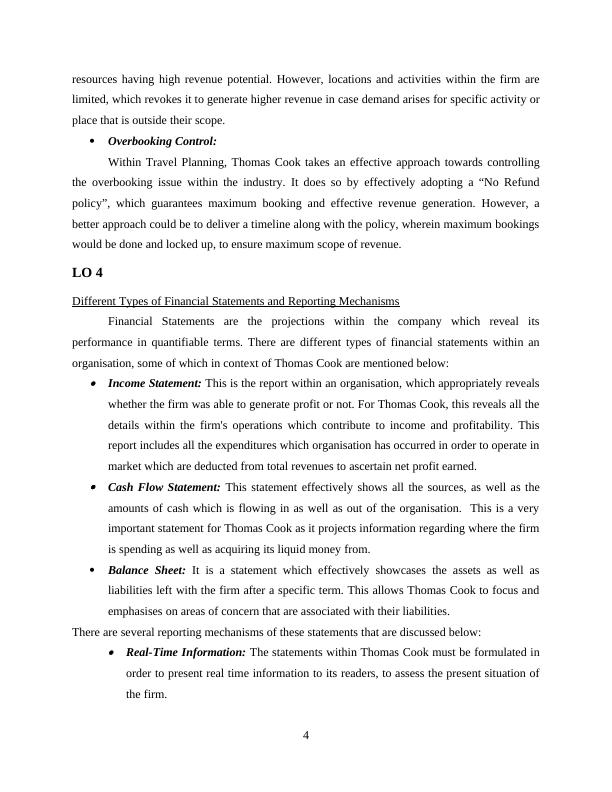
End of preview
Want to access all the pages? Upload your documents or become a member.
Related Documents
The Travel and Tourism Business Toolkit - Assignment (Solution)lg...
|13
|3787
|68
Rationale and Principles of Revenue Management in Travel and Tourism Industrylg...
|14
|3722
|30
Unit 4 - The Travel and Tourism Business Toolkitlg...
|12
|4009
|84
Principles of Revenue Management - Doclg...
|11
|2766
|133
Principles of Revenue Management- Doclg...
|9
|2871
|140
Travel &Tourism Management Solved Assignmentlg...
|13
|4171
|54
